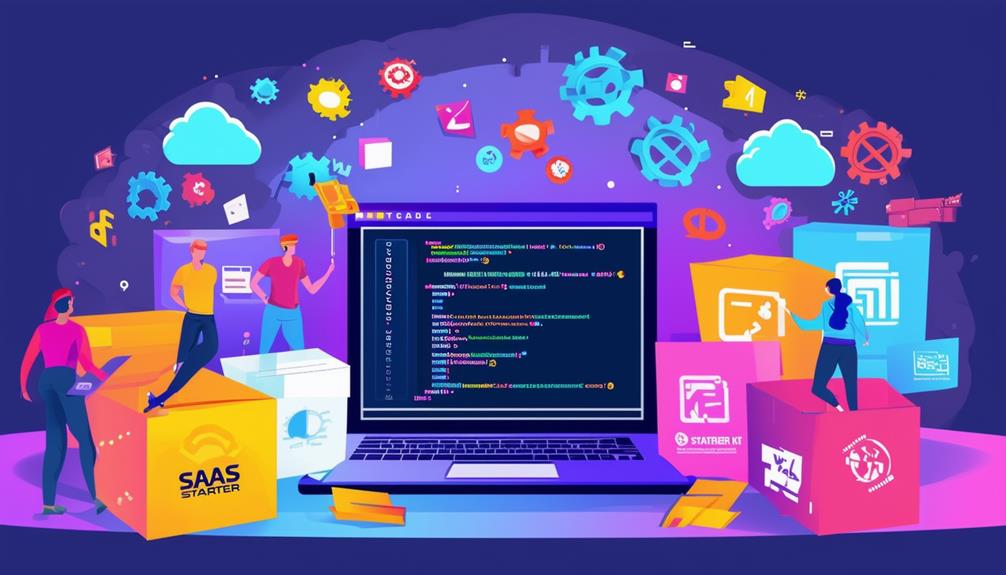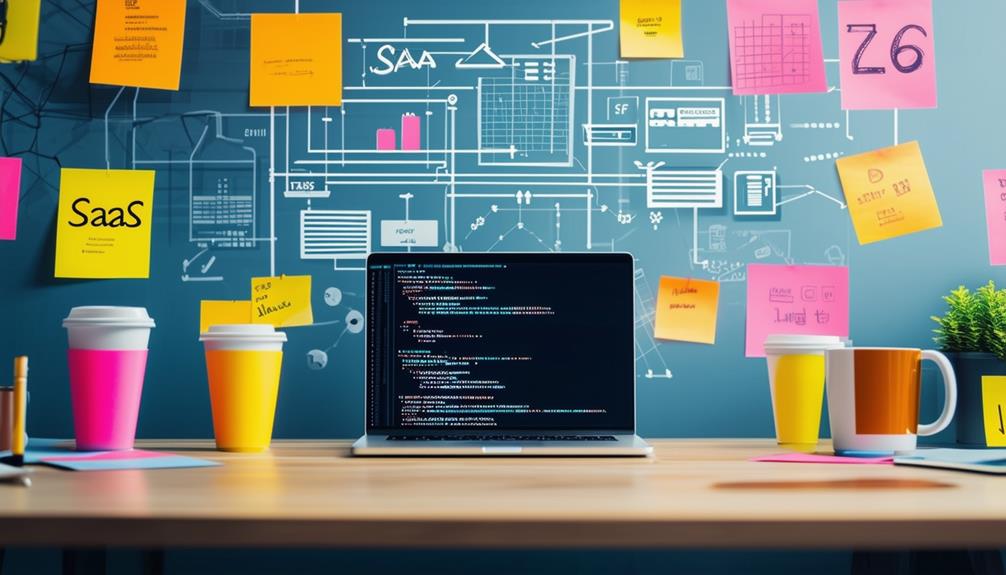When you’re building a SaaS application, starting with a solid boilerplate can save you countless hours and headaches. But with so many options available, how do you know which features are truly essential? You’ll want to guarantee your chosen boilerplate includes robust authentication, seamless billing integration, and scalable architecture, among other key components. Understanding these vital elements can make the difference between a smooth development process and a frustrating one. Let’s explore the top 10 features you should be on the lookout for in a SaaS boilerplate, and why they’re critical for your project’s success.
Authentication and User Management
Nearly every SaaS boilerplate includes robust authentication and user management features, ensuring you’ve got a solid foundation for secure access control from the start. These features are vital for protecting your users’ data and maintaining the integrity of your application.
Look for a boilerplate that offers multi-factor authentication (MFA), which can reduce account takeover risks by up to 99.9%, according to Microsoft. You’ll also want user role management capabilities, allowing you to define and assign different access levels easily. This granular control is fundamental for compliance with regulations like GDPR and HIPAA.
Don’t overlook the importance of password policies and recovery options. A good boilerplate should enforce strong password requirements and provide secure password reset mechanisms. According to a Verizon report, 80% of data breaches involve weak or stolen passwords, highlighting the need for robust password management.
Single Sign-On (SSO) integration is another valuable feature, streamlining the login process for users while maintaining security. It can reduce password fatigue and improve user experience, with studies showing SSO can cut login-related helpdesk costs by 50%.
Subscription Billing Integration
While robust user management lays the foundation, you’ll need a reliable subscription billing system to monetize your SaaS product effectively.
A good SaaS boilerplate should offer seamless integration with popular payment gateways and billing platforms like Stripe, PayPal, or Braintree.
Look for features that support various pricing models, including monthly, annual, and custom plans. The ability to handle free trials, promo codes, and discounts is essential for customer acquisition and retention. According to a study by ProfitWell, companies offering multiple pricing tiers see 44% higher growth rates than those with a single tier.
Your boilerplate should also include tools for managing subscription lifecycles, automating recurring billing, and handling payment failures gracefully. Dunning management capabilities can help reduce churn by up to 30%, as reported by Baremetrics.
Make sure the billing integration supports detailed financial reporting and analytics. This data will be invaluable for tracking revenue, monitoring customer lifetime value, and making informed business decisions. A robust billing system can increase your average revenue per user by 25%, according to ChartMogul’s industry benchmarks.
Scalable Architecture
How can you guarantee your SaaS product can handle rapid growth? A scalable architecture is fundamental for accommodating increasing user loads and data volumes without compromising performance or reliability.
When evaluating a SaaS boilerplate, look for features that support horizontal and vertical scaling. Horizontal scaling allows you to add more servers to distribute the load, while vertical scaling involves upgrading existing hardware. A well-designed boilerplate should support both approaches.
Look for microservices architecture, which enables independent scaling of individual components. Ensure the boilerplate includes load balancing capabilities to evenly distribute traffic across multiple servers. This feature is essential for maintaining ideal performance during traffic spikes.
Additionally, check for database sharding support, which allows you to partition data across multiple databases, improving query performance and scalability. Caching mechanisms are another important component of a scalable architecture.
Look for built-in support for distributed caching solutions like Redis or Memcached. These tools can greatly reduce database load and improve response times.
Security Measures
In light of increasing cyber threats, robust security measures are a non-negotiable feature for any SaaS boilerplate you’re considering. Your chosen solution should offer extensive protection against common vulnerabilities and emerging risks.
Look for built-in authentication mechanisms like multi-factor authentication (MFA) and single sign-on (SSO). These features can reduce unauthorized access attempts by up to 99.9%, according to Microsoft. Confirm the boilerplate supports data encryption both at rest and in transit, using industry-standard protocols like AES-256 and TLS 1.3.
A solid SaaS boilerplate should also include role-based access control (RBAC) to manage user permissions effectively. This granular control helps prevent data breaches caused by overprivileged accounts, which account for 74% of data breaches, as reported by IBM.
Don’t forget about compliance features. Your boilerplate should offer tools to help you meet industry standards like GDPR, HIPAA, or SOC 2. These might include consent management systems, data retention policies, and audit logs.
Lastly, check if the boilerplate includes regular security updates and patches. Staying current with the latest security fixes is vital in maintaining a robust defense against evolving threats.
API and Third-Party Integrations
A robust SaaS boilerplate should come equipped with flexible API capabilities and seamless third-party integrations to boost your app’s functionality and user experience.
These features are vital for scaling your product and meeting diverse user needs. According to a 2022 report by API-first company Postman, 89% of developers expect to use APIs more or the same in the coming year, underscoring their importance.
Your boilerplate should offer RESTful API support, allowing easy data exchange between your app and external services.
Look for pre-built integrations with popular third-party tools like payment gateways (Stripe, PayPal), analytics platforms (Google Analytics, Mixpanel), and communication services (Twilio, SendGrid). These save you time and development resources.
Ensure the boilerplate includes robust API documentation and SDKs in multiple programming languages. This makes it easier for developers to integrate your service into their workflows.
Additionally, check for webhook support, enabling real-time data updates and automations.
A well-designed API management system with rate limiting and authentication features is essential for maintaining security and performance as your user base grows.
Customizable UI Components
Customizable UI components are the backbone of a flexible SaaS boilerplate, allowing you to quickly build and modify your app’s interface to match your brand and user needs. These pre-built elements, such as buttons, forms, and navigation menus, can be easily styled and adapted to fit your specific requirements.
According to a recent survey, 87% of SaaS companies consider customizable UI components vital for rapid development and maintaining brand consistency. By leveraging these components, you’ll save countless hours of design and development time, enabling you to focus on your core business logic.
Look for boilerplates that offer a wide range of UI components, including responsive layouts, data visualization tools, and interactive elements. Confirm they’re built with modern frameworks like React or Vue.js for peak performance and scalability.
It’s also essential that the components are well-documented and follow accessibility guidelines to guarantee your app is usable by all.
Many top SaaS boilerplates now include theming systems, allowing you to easily change colors, typography, and other design elements across your entire application with just a few lines of code. This feature can reduce design inconsistencies by up to 60%, according to industry experts.
Database Management
While UI components shape your app’s frontend, robust database management forms the backbone of your SaaS application’s backend infrastructure. A quality SaaS boilerplate should offer seamless integration with popular database systems like PostgreSQL, MongoDB, or MySQL. Look for features that simplify data modeling, migrations, and schema management.
You’ll want built-in support for database scalability and performance optimization. This includes connection pooling, query caching, and automated indexing. Efficient data retrieval is essential, so seek boilerplates that offer ORM (Object-Relational Mapping) tools or query builders to streamline database operations.
Security is paramount in database management. Verify your chosen boilerplate includes features like data encryption, access control, and protection against SQL injection attacks. It should also facilitate regular backups and provide easy restoration options.
Don’t overlook the importance of database monitoring and logging capabilities. These features help you track performance metrics, identify bottlenecks, and troubleshoot issues quickly.
Deployment and DevOps Tools
To streamline your SaaS application’s lifecycle, you’ll need robust deployment and DevOps tools integrated into your boilerplate. These tools can greatly reduce time-to-market and improve overall operational efficiency.
Look for boilerplates that offer containerization support, such as Docker, which enables consistent deployment across various environments. Kubernetes integration is also vital for orchestrating and scaling your containers effectively.
Your boilerplate should include continuous integration and continuous deployment (CI/CD) pipelines. Popular options like Jenkins, GitLab CI, or GitHub Actions can automate your build, test, and deployment processes.
Infrastructure-as-Code (IaC) tools like Terraform or AWS CloudFormation should be part of the package, allowing you to version and manage your infrastructure alongside your code.
Don’t overlook monitoring and logging capabilities. Integrated tools like Prometheus, Grafana, or ELK stack (Elasticsearch, Logstash, Kibana) can provide valuable insights into your application’s performance and help quickly identify issues.
Automated backup and disaster recovery solutions are essential for data protection and business continuity.
Analytics and Reporting
Five key analytics and reporting features should be baked into your SaaS boilerplate, empowering you to make data-driven decisions and optimize your product’s performance.
First, look for user behavior tracking that captures clicks, page views, and time spent on various features. This data helps you understand how customers interact with your application and identify areas for improvement.
Second, verify your boilerplate includes conversion funnel analysis. This feature allows you to track users’ journey from sign-up to paid subscription, pinpointing where potential customers drop off.
Third, opt for a solution with customizable dashboards that display key performance indicators (KPIs) at a glance, such as monthly recurring revenue, churn rate, and customer lifetime value.
Fourth, seek out cohort analysis capabilities to group users based on common characteristics or behaviors, helping you identify trends and patterns over time.
Multi-tenancy Support
Multi-tenancy architecture forms the backbone of any scalable SaaS boilerplate, allowing you to serve multiple clients from a single instance of your application. This approach greatly reduces infrastructure costs and simplifies maintenance, making it a must-have feature for your SaaS platform.
When evaluating a SaaS boilerplate, look for robust multi-tenancy support that includes data isolation and security measures. You’ll want a system that can efficiently manage tenant-specific data, configurations, and customizations without compromising performance or security. According to a recent study, 78% of successful SaaS companies attribute their scalability to effective multi-tenancy implementation.
Your chosen boilerplate should offer flexible tenant management options, such as easy onboarding, offboarding, and tenant-specific feature toggles. It’s essential to have a clear separation of concerns between tenant data and shared resources. This separation guarantees data privacy and compliance with regulations like GDPR.
Additionally, consider how the boilerplate handles resource allocation and load balancing across tenants. A well-designed multi-tenant architecture can help you optimize resource usage and maintain consistent performance for all your clients, even as your user base grows.
To Wrap Up
You’ve got the top 10 features to look for in a SaaS boilerplate.
By prioritizing these elements, you’ll guarantee your application is robust, secure, and scalable.
Don’t forget to take into account your specific needs and industry requirements when making your final decision.
With the right boilerplate, you’ll save time and resources while building a solid foundation for your SaaS product.
Keep these features in mind, and you’ll be well on your way to success.






